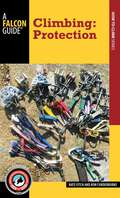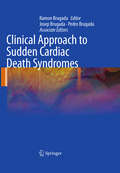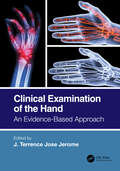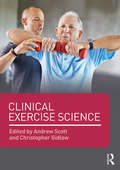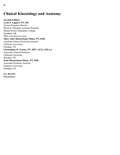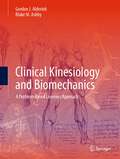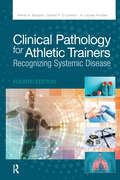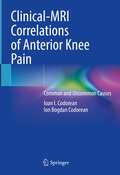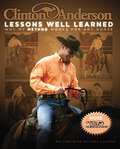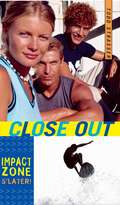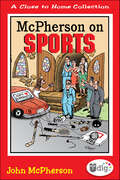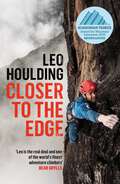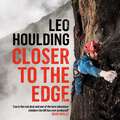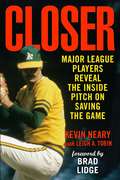- Table View
- List View
Climbing: Knots
by Nate Fitch Ron FunderburkeClimbing: Knots features instructional knot-making information for the novice climber. Pocket-size, it's portable and easy-to-use, with photos throughout to assist with learning.
Climbing: Protection
by Nate Fitch Ron FunderburkeClimbing: Protection is a pocket-size instructional climbing book with the backing of the American Mountain Guides Association (AMGA) that focuses on climbing protection and safety. Complete with color photos throughout, the book features information on environment and terrain, best practices, gear, and more.
Clinical Approach to Sudden Cardiac Death Syndromes
by Josep Brugada Ramon Brugada Pedro BrugadaClinical cardiologists are encountering an important challenge in the caring of families with inherited cardiac diseases. The majority of the inherited cardiac diseases causing sudden death express themselves at variable ages in the form of altered muscle function (i.e hypertrophic or dilated cardiomyopathy) or in the form of arrhythmias (i.e. Brugada syndrome, long QT syndrome). However, it is not uncommon that the first sign of the disease may actually be sudden cardiac death, even before the identification of clear clinical abnormalities. In this last decade, with more than 50 new disease-associated genes identified, the possibility of genetic testing has opened a new opportunity to disease diagnosis and prevention. Clinical and genetic research is continuously on-going not only to identify those at risk, but to better define their level or risk still with limited success.
Clinical Examination of the Hand: An Evidence-Based Approach
by J. Terrence Jose JeromeThis handbook brings together the basic elements of hand and upper limb cases, from examination to clinical diagnosis of various hand and upper limb related diseases. It improvises the examination skills of the reader with proficiency to arrive at a provisional diagnosis for the given hand surgery and related diseases. The chapters are presented with simple language, clinical pictures, tables and embedded videos for readers. Written by contributors across the globe, this book is useful for trainees, graduates, postgraduates, and fellows who intend to brush up ontheir basics and excel in hand surgery. Key Features• Focuses on examination of hand and upper limb cases.• Serves as an illustrated reference of clinical examination for trainees, graduates, post-graduates and fellows.• Uses high-quality operative videos to demonstrate the clinical examination of various diseases of the hand and upper limb.
Clinical Exercise Science
by Andrew Scott Christopher GidlowClinical Exercise Science is an introduction to core principles and best practice in exercise science for students and practitioners working with clinical populations. Combining the latest scientific research with evidence-based, practitioner-led analysis, the book offers integrated coverage of the full clinical exercise curriculum, including: Pathophysiology of exercise and disease Exercise as a clinical intervention Exercise, nutrition, and lifestyle Health behaviour change Clinical skills in exercise science The book covers a wide range of conditions, including cardiovascular disease, pulmonary disease, metabolic disease and mental health problems, and includes an array of useful features to guide student learning, such as case studies, study tasks, definitions of key terms and suggestions for further reading. With contributions from leading researchers and health practitioners, this is an invaluable foundation text for any clinical exercise science course, and useful reading for any student or practitioner working in exercise science, exercise rehabilitation, health science or physical therapy.
Clinical Guide to Musculoskeletal Medicine: A Multidisciplinary Approach
by S. Ali Mostoufi Tony K. George Alfred J. Tria Jr.This unique clinical guide will explore specific evidence-based literature supporting physical therapist guided exercises and interventional treatments for commonly prevalent orthopedic spine and extremity presentations. Using this book, the sports medicine and interventional pain physician will be better able to coordinate therapy exercises after interventional treatments with their physical therapy colleagues. This will include a treatment course that will monitor progress in restoring and accelerating patients’ function. A myriad of musculoskeletal conditions affecting the spine, joints and extremities will be presented, including tendinopathies, bursopathies, arthritis, fractures and dislocations - everything a clinician can expect to see in a thriving practice. Each chapter, co-authored by a physician and a physical therapist, will follow a consistent format for ease of accessibility and reference – introduction to the topic; diagnosis; medical, interventional, and surgical management – and will be accompanied by relevant radiographis, figures and illustrations. Additional topics include osteoarthritis, rheumatic disorders, entrapment syndromes, the use of orthobiologics, and more. Comprehensive enough to function as a learning tool, but practical and user-friendly enough for quick reference, Clinical Guide to Musculoskeletal Medicine will be an essential resource for sports medicine physicians, interventional and physical therapists.
Clinical Kinesiology and Anatomy
by Lynn S. Lippert F. A. DavisClinical Kinesiology and Anatomy, 7th Edition and an updated and enhanced Kinesiology in Action work together to create an immersive, multimedia experience that tracks your progress until you’ve mastered the must-know primary concepts and principles of human movement and are ready to apply them in class, clinic, and practice. You’ll develop the foundational knowledge, critical-thinking skills, and technical competencies you need to understand kinesiology.
Clinical Kinesiology and Biomechanics: A Problem-Based Learning Approach
by Gordon J. Alderink Blake M. AshbyThis new textbook uses a problem-based learning (PBL) approach for teaching the fundamentals of kinesiology and biomechanics to undergraduate and graduate students in the biomedical, rehabilitative, and exercise science fields. Case vignettes and problems for each major region of the body are presented – cervical spine, thoracic spine and rib cage, lumbar spine and pelvis, shoulder girdle, elbow/forearm, wrist, hand, hip, knee, and ankle/foot. For the cases on the spine and upper extremity, biomechanics of posture are included; for cases involving the hip, knee, and ankle/foot, an extensive study of gait analysis is also incorporated. These case vignettes are not preceded by chapters that provide foundational information. Rather, relevant anatomical, biomechanical, and other information needed to solve/explain each case are embedded in the relevant chapters presenting the clinical cases.
Clinical Nutrition in Athletic Training
by Mark KnoblauchClinical Nutrition in Athletic Training is the definitive nutrition textbook for athletic training educational programs, providing athletic trainers with foundational knowledge in clinical-based concepts specific to the field of nutrition.Editor Dr. Mark Knoblauch and his contributors draw upon nutrition-based requirements outlined in the 2020 Commission on Accreditation of Athletic Training Education (CAATE) educational standards, as well as from the input of practicing athletic trainers and dietitians.This book gives an overview of the energy systems, macronutrients, and micronutrients that are often intertwined with nutrition. Each chapter includes real-life tips from the field, providing readers with a unique and practical learning experience.What’s covered in Clinical Nutrition in Athletic Training: Supplements and their use in clinical nutrition A detailed overview of fluid management Chapters specifically devoted to nutrition and disease, as well as eating disorders How to interpret food labeling An outline written by a dietitian on how to conduct a proper nutrition counseling session Tips on discussing nutrition with patients and athletes Clinical Nutrition in Athletic Training explores how proper nutrition may be able to reduce the incidence of injury in some individuals. With sections focused on direct patient care aspects of nutrition and how nutrition is involved in weight management, this book also examines how nutrition requirements change based on the type and level of physical activity an individual is engaged in.Clinical Nutrition in Athletic Training is an easy-to-read resource that will equip athletic trainers with the knowledge to care for and educate their patients and athletes on nutrition.
Clinical Pathology for Athletic Trainers: Recognizing Systemic Disease
by Daniel O'Connor Rehal Bhojani A. Louise FincherNewly updated with the latest professional content standards, Clinical Pathology for Athletic Trainers: Recognizing Systemic Disease, Fourth Edition provides insight on medical conditions frequently encountered in athletic training. Consistent with the profession’s shift toward the medical model, this Fourth Edition is complemented by the addition of a sports medicine physician’s perspective. Drs. Rehal A. Bhojani, Daniel P. O’Connor, and A. Louise Fincher have written this new edition to emphasize practical knowledge, clinical skills, and decision-making skills. Incorporating up-to-date standards from the Commission on Accreditation of Athletic Training Education, National Athletic Trainers’ Association position statements, and the latest guidelines for medical conditions of various organ systems, this text reflects the continued growth and evolution of the athletic trainer’s role as a health care professional. It provides comprehensive knowledge that can be adapted to clinical practices, urgent cares, academics, research, and more.The Fourth Edition includes updated: Cases Evidence and references Position statements NATA and professional documents Information on assessment, evaluation, and treatment Included with purchase is a supplemental website. Perfect for athletic trainers, athletic training students, and other health care professionals working with physically active populations throughout the lifespan, Clinical Pathology for Athletic Trainers: Recognizing Systemic Disease, Fourth Edition is a must-have for any practitioner seeking to develop their clinical skills.
Clinical Practice to Academia: A Guide for New and Aspiring Health Professions Faculty
by Crystal GateleyDesigned to assist health professionals with the transition from a clinical role to a faculty role, Clinical Practice to Academia: A Guide for New and Aspiring Health Professions Faculty provides a comprehensive overview of higher education for new and aspiring faculty across health professions including occupational therapy, physical therapy, athletic training, nursing, speech-language pathology, clinical and diagnostic sciences, and pharmacy. This practical guide explores the complexities of the faculty role and includes specific strategies related to teaching and learning in the health professions. Written by Dr. Crystal A. Gateley, Clinical Practice to Academia includes an overview of the issues most impacting academics today. Chapters are placed within the context of current health care and higher education settings. Conceptual foundations of teaching and learning are reviewed, and specific strategies for classroom instruction are provided. The text also includes suggestions for ongoing professional development through the first few years and beyond. Unique aspects of Clinical Practice to Academia include: Introduction to institutional differences that affect faculty roles Focus on the first few years of an academic career Recommendations for exploring campus and professional resources Overview of today’s college students Self-directed learning activities in each chapter for further exploration of topics With practical advice that can be tailored to unique faculty roles, Clinical Practice to Academia: A Guide for New and Aspiring Health Professions Faculty is a must-have for any health care professionals who are moving into academia.
Clinical Skills Documentation Guide for Athletic Training
by John Hauth Brian Gloyeske Herb AmatoFor more than 15 years, Clinical Skills Documentation Guide for Athletic Training has been an invaluable resource for athletic training students to learn, practice, and master clinical skill sets throughout their educational career. A textbook that can be used from the start of their education up until graduation becomes essential to this learning process.Clinical Skills Documentation Guide for Athletic Training, Third Edition includes a more user-friendly layout for the student. Organized by the Athletic Training Education Competencies, Fifth Edition and the associated content areas, this Third Edition allows for easier integration into the classroom, laboratory activities, and clinical assessment.The organization of skills around Athletic Training Education Competencies, Fifth Edition, including crosswalk information from the latest BOC Role Delineation Study/Practice Analysis, Sixth Edition, aligns the skill sheets from Clinical Skills Documentation Guide for Athletic Training, Third Edition with commonly used texts and reference materials.What is in the Third Edition: A user-friendly layout organized by the Athletic Training Education Competencies, Fifth Edition and mapped by the BOC domains New clinical skill assessment forms in the areas of acute care, prevention and health promotion, and therapeutic interventions Includes references to specificity, sensitivity, and evidence-based practice guidelines where appropriate The Program Assessment chapter provides faculty with an excellent resource for tracking mastery of skills and program outcome achievement Instructor’s materials consist of online versions of the clinical integration proficiencies Included with the text are online supplemental materials for faculty use in the classroom.With an updated user-friendly layout and new clinical skill assessment forms, the Third Edition of Clinical Skills Documentation Guide for Athletic Training will be invaluable for students, faculty, clinical preceptors, and practicing athletic trainers who want to learn or enhance understanding and mastery of essential clinical skills.
Clinical-MRI Correlations of Anterior Knee Pain: Common and Uncommon Causes
by Ioan I. Codorean Ion Bogdan CodoreanThe book addresses comprehensively the normal and pathological MRI appearance of the structures of the anterior compartment of the knee, potential sources of pain, in a systematic way, on anatomical layers, from superficial to deep, respectively, from prepatellar soft tissues to intra-articular structures (the synovial lining, patellar and trochlear cartilage). Anterior knee pain can affect any age group and causes a non-specific clinical picture, making it difficult to establish a precise diagnosis and proper management. MRI is currently the standard gold investigation and findings of common an uncommon causes of anterior knee pain are presented.Written by a radiologist and an orthopaedic surgeon with longstanding experience in MRI of musculoskeletal pathology and in sports traumatology, respectively, the book also presents a unique selection of 80 clinical cases of common and less common pathological conditions of anterior knee pain and subdivided in four groups, according to age, from children and adolescents to older adults.Radiologists and orthopaedic surgeons, as well as sport medicine specialists and physiatrists, will find in this book an invaluable tool for their clinical practice.
Clinton Anderson Philosophy
by Clinton AndersonThe key to enjoying a safe, fun, and fulfilling partnership with your horse is having the knowledge and confidence to lead and train him. All great partnerships are based on three elements: trust, respect, and communication. Whenever one element is lacking, the partnership fails to form or ceases to exist. When it comes to interacting with horses, we unintentionally tend to be our own worst enemies. By design, horses and humans perceive the world from opposite ends of the scale: horses are prey animals with an ingrained flight or fight response, and humans are predators. Because of this, before you train a horse, you have to understand basic horse psychology and what makes your horse tick. When you know how the horse processes his thoughts and why he does the things that he does, both good and bad, you can accomplish anything. If you don't understand how your horse perceives the world around him, then you will struggle with your horsemanship goals. Clinician Clinton Anderson knows good horsemanship isn't always easy. With over 20 years of experience working with horses and helping people safely train them, Clinton has become an expert at bringing out the best in both. In this highly illustrated book, he shares his philosophy, knowledge and wisdom, detailing what he feels every person should know about horses before working with them. Breaking down the crucial elements of his method of horsemanship, Clinton explains how to become an effective leader that your horses will look to for guidance and how to successfully start a mutually enjoyable partnership. Readers will learn what motivates horses, the basics of respect and why it must be established, and the role pressure and body language play in communicating. Clinton prescribes a tried-and-true formula to train a well broke horse and discusses the three elements that go into becoming an all-around great horseman. Filled with commonsense explanations and personal anecdotes from Clinton's life, the lessons in Philosophy provide the instruction and inspiration needed to help you achieve your horsemanship dreams.
Clinton Anderson's Downunder Horsemanship
by Clinton AndersonIf you have seen his weekly television program, Downunder Horsemanship, then you know that Clinton Anderson's training techniques can achieve amazing results with almost any horse. Now his methods are available for the first time in a reader-friendly, highly illustrated book, and you, too, can learn the program that teaches everyday people—regardless of riding style, age, or ability—how to better communicate with their mounts.
Clinton Anderson: Lessons Well Learned
by Clinton AndersonThis engaging handbook examines the unparalleled effectiveness of the Downunder Horsemanship method of horse training and demonstrates how to apply the knowledge to everyday equestrian activities. Illustrated.
Clips of the Week
by Paul Hawksbee Andy JacobsEvery Friday afternoon at 3. 30, the whole office at talkSPORT Towers stops to listen to the station's most popular feature, Clips of the Week, presented by Paul Hawksbee and Andy Jacobs. For all the professionalism of the presenters, there are always those moments when things don't quite go right, and words get jumbled up, or a guest on a phone-in says something so extraordinary you have to stop and think: did he really just say that? For 13 years now, the hosts of the afternoon show have been running this feature, in the process collecting almost 4000 hilarious clips. In this book we get to read the very best of the best; they include Alan Brazil's occasional on-air lapses, as when he introduced racing reporter Rupert Bell: 'Here's talkSPORT's Rupert Bear. . . '. There's also the unbeatable moment when a Scottish caller was campaigning for Hearts' goalkeeper Antti Niemi to play for Scotland. The presenter replied that he was ineligible as he was Finnish, only to be told: 'He's no' finish, he only 28!'
Close Out
by Todd StrasserIMAPCT ZONE The most dangerous part of the wave You gotta beat it...or you'll eat it. The summer is hot, and so is action out on the line-up. There's a big competition coming up, with some serious burrito money attached. All the brahs are in it for something. Lucas has his career and his reputation on the line. If Kai wins, he might be able to stay in Sun Haven and not have to hit the road again with his sketchy dad. For everyone it's a chance to close out the summer as a champion. Stoked.
Close to Home: A Medley of Outrageous Sports Cartoons
by John McPhersonSports is one of cartoonist John McPherson's favorite topics for lampooning. The frustration inherent in almost any sport makes for a perfect comic target. What's funnier than a flummoxed fisherman, a goaded golfer, a bamboozled batter, or a fumbling football player? Find out in this collection of John's favorites.Close to Home debuted in 50 newspapers in 1992 after McPherson left his engineering job to become a full-time cartoonist, and today the comic strip runs in nearly 700 newspapers worldwide. His characters are regularly confronted with everyday dilemmas and their responses are always cleverly unpredictable. The situations are somehow both outlandish yet relatable, and anyone is sure to burst out in laughter at this original e-book collection of all of Close to Home&’s boldest and best comical takes on sports.
Close to the Wind: An Extraordinary Story of Triumph Over Adversity
by Pete GossPete Goss became a national and international hero when he rescued French yachtsman Raphael Dinelli as his boat sank beneath him in the round-the-world single-handed sailing race, the Vendee Globe, on Christmas Day 1996. In doing so Pete scuppered his own chances in the race but was awarded theLegion d'Honneur by France's president and made a friend for life in Dinelli.Close to the Wind is his own story of the race and its dramas, his revolutionary boat,Aqua Quorum, his thoughts and emotions during four months of solitude at sea, the extraordinary surgery that he had to perform on his own elbow and the aftermath of the rescue in the Southern Ocean.
Close to the Wind: An Extraordinary Story of Triumph Over Adversity
by Pete GossPete Goss became a national and international hero when he rescued French yachtsman Raphael Dinelli as his boat sank beneath him in the round-the-world single-handed sailing race, the Vendee Globe, on Christmas Day 1996. In doing so Pete scuppered his own chances in the race but was awarded theLegion d'Honneur by France's president and made a friend for life in Dinelli.Close to the Wind is his own story of the race and its dramas, his revolutionary boat,Aqua Quorum, his thoughts and emotions during four months of solitude at sea, the extraordinary surgery that he had to perform on his own elbow and the aftermath of the rescue in the Southern Ocean.
Close-up: Forensic Photography (The Crime Scene Club, Case #5)
by Kenneth McintoshWhen the members of the Crime Scene Club visit Los Angeles, they become involved in an investigation into what appears to be the accidental death of a surfer. Includes bibliographical references and index.
Closer to the Edge: Climbing to the Ends of the Earth
by Leo HouldingOne of Great Britain's finest climbers and adventurers, Leo Houlding started out climbing at ten years of age in the Lake District literally learning the ropes tackling the many historic peaks and crags in the area. Honing his skills as he grew, at eighteen Leo became one of the very first to free climb the mighty El Capitan in the Yosemite Valley, California widely regarded as the most impressive rock face on the planet cementing his reputation as a world class climber. He has since gone on to not only summit the world's tallest walls and toughest peaks, but has become a twenty-first Century explorer, crossing continents to take extreme sports to the most remote corners of Earth - from the frozen mountains of Antarctica to the sweltering jungles of South America How did a working class lad from the north of England scale such heights and avoid the pitfalls and fatal accidents that have struck down so many of his colleagues and friends? Honest, raw and exhilarating, Closer to the Edge is Leo's 'warts-and-all' insight into the extreme life of one of Britain's best climbers who is active today and still planning epic adventures. In a page-turning narrative, Leo describes his childhood inspirations to climb, his mentors who guided him, and the exhilaration of those teenage years when he broke into the public consciousness - such as his infamous race against Jeremy Clarkson on Top Gear. He will reveal to the reader what drives him, how he assesses risk and judges how close to the edge he can go and return safely, and how he balances this with teaching his own children the lessons he has learnt in some of the world's most dangerous and extreme places. Closer to the Edge is the story of a remarkable climber and free spirit who has been at the top of his game for over thirty years, with still more mountains to explore.
Closer to the Edge: Climbing to the Ends of the Earth
by Leo HouldingLeo Houlding started climbing at ten years of age in the Lake District and was the youngest person (and first Briton) to free climb El Capitan in Yosemite National Park in the United States at eighteen years, which cemented his reputation. He has since gone on to summit the world's toughest peaks and explore the most extreme places on our planet. During such explorations he has had to deal with tragedy when close friends and colleagues have been killed or badly injured, and he will discuss how you deal with such loss and carry on. Honest, raw and exhilarating, Closer to the Edge will be a 'warts-and-all' insight into the extreme life of one of Britain's best mountaineer adventurers. What drives him? How does he assess risk and judge what level he'll take himself to be successful, and how does he balance this with teaching his own children the lessons he has learnt in some of the world's most dangerous and extreme places.(P) 2022 Headline Publishing Group Ltd
Closer: Major League Players Reveal the Inside Pitch on Saving the Game
by Leigh A. Tobin Brad Lidge Kevin NearyThe closer is the ace reliever who specializes in closing out the game without surrendering the lead. Facing a power hitter in the ninth inning with a man on base and no outs takes nerves of steel. The pressure on the mound is intense. It takes a special breed to hold it together in these situations. Legendary manager Tony LaRusso said "Sure, games can get away from you in the seventh and eighth, but those last three outs in the ninth are the toughest. ” It wasn’t until the creation of "the save,” the successful maintenance of a lead by a relief pitcher, in 1960 that the position of closer began to rise in prominence. Today, closers are seen as some of the most intense athletes in all of sports. Neary and Tobin explore the unique personalities of major leagues’ most prominent relief pitchers from Bruce Sutter (Cubs, Cardinals, and Braves) to Mariano Rivera (Yankees). Closer is an insider’s look into the role of the closing pitcher, how the position has evolved, and how legends-Trevor Hoffman, Rollie Fingers, Dennis Eckersley, John Smoltz, Rich "Goose” Gossage, Mariano Rivera, Brian Fuentes, and many more-coped with the stress on the mound such as when facing the . 340 batter in the bottom of the ninth with only a one run lead.

